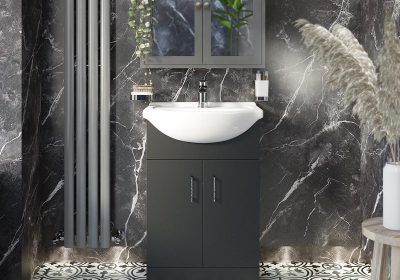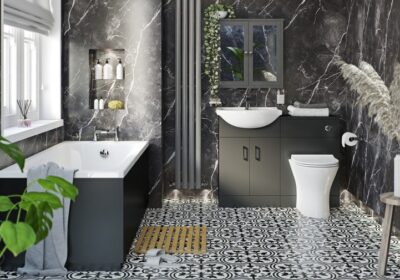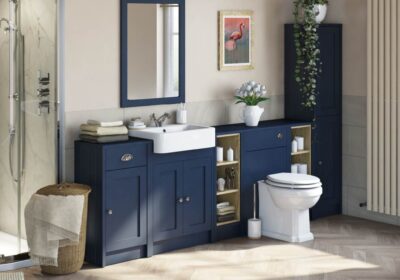Blocked toilet? Don’t fret, there is a much faster, easier, and cleaner way to get your toilet unclogged and prevent future blockages that don’t involve using rubber gloves.
Quick Review of Key Points
The best way to prevent a blocked toilet is to not flush anything other than toilet paper. Additionally, be mindful of the amount of toilet paper you use at once and avoid flushing any objects such as feminine hygiene products.
What Causes a Blocked Toilet?
There are several potential explanations for why a toilet becomes blocked. The most common cause is the build-up of excess waste and blockages in the pipes which can be caused by flushing something that wasn’t meant to be flushed, such as tissue paper, diapers, or sanitary products. Other causes include objects such as toys being accidentally flushed down the toilet and becoming lodged in the plumbing or an accumulation of foreign objects from previous attempts to unblock it.
The debate between these two sides centres around whether the primary reason for blocked toilets should be attributed to faulty plumbing systems or incorrect user behaviour. Those on one side argue that it is mostly due to items that were not intended to be flushed being flushed in a hurry by forgetful people. On the other hand, some refute this claim and instead insist that most problems come from faulty plumbing designs or lack of proper maintenance.
Evidence for either side mostly relies on observation of causes seen in professional practice when dealing with blocked toilets. Based on these experiences, it seems to point towards user behaviour being the more prominent cause rather than poor plumbing design or systematic errors. This conclusion can be drawn based on the fact that improper flushing is quite easily prevented, whereas resolving structural issues with a plumbing system requires quite a bit more effort and time investment.
Overall, blocked toilets can be a frustrating issue regardless of what causes them; however, understanding where the problem comes from is an important step in taking preventive measures against recurrences in the future. Now let’s take a look at what to do about clogged drains and pipes which may also be causing problems in your home.
Clogged Pipes and Drains
Clogged pipes and drains can be a common issue in many homes due to the build up of grease, hair, soap scum, dirt and other debris. This is usually a result of the accumulation of these materials over time, rather than being caused by a single blocked toilet. In order to prevent pipe clogs from occurring, there are several steps that homeowners should take.
One measure to take is to keep a lookout for any signs of blockage and address them immediately. Signs include slow draining water or gurgling noises coming from the pipes when using certain fixtures such as showers and sinks.pipe Inspection cameras are also useful tools in detecting if there are anything blocking your pipes, such as obstructions or broken pipes. Additionally, it can help with figuring out the cause of the clog; whether it’s due to roots growing into the pipe or something more serious like a collapsed pipe. Regular drain cleaning with chemical cleaners can also help reduce the risk of blockages occurring.
In some cases however, a plumbing contractor may need to be consulted to resolve the issue. If this is the case, homeowners should seek professional advice on what course of action would be necessary to resolve any blockages in their drainage system; they may need to have their pipes replaced entirely or repair existing damage in order to avoid further issues down the line.
It’s important for homeowners to understand how best to protect their pipes and drains against clogs so that incidents like blocked toilets become rare occurrences instead of an everyday problem. By taking proactive steps and knowing how to spot any signs of blockage before it becomes an issue, homeowners can ensure their drainage system remains clean and running smoothly. Taking such measures now will not only contribute towards preventing future blocked toilet disasters but also save you money further down the road – by avoiding costly repairs!
Having an idea of what causes blocked toilets can now allow us to move on how build up of waste over time may lead our toilets being blocked up if not taken care of properly.
Build up of Waste
When dealing with a clogged toilet, it is important to identify the cause of the clog. One of the most common causes of a blockage is the build up of waste. This can include everything from human waste to wipes, feminine hygiene products, baby diapers, and other household items that weren’t made for toilets. These items don’t dissolve as easily as toilet paper and get stuck in drains, pipes, and even your sewer line.
Excessive use of toilet paper or other items believed to be safe for your plumbing system can also lead to a build up of waste. The material may dissolve slightly over time but eventually accumulates enough to block water flow. Additionally, hard water can create soap scum on bathroom fixtures and surfaces that can also build up in sewage lines over time.
All of these causes may contribute to clogged toilet pipes and drains, making it difficult for proper drainage to occur. While many pipes are able to withstand small amounts of build up for extended periods before becoming clogged, when this happens quickly or builds up significantly, you may be looking at more than just a simple plumbing issue. To prevent further issues from occurring, it’s important to take steps towards preventing build up of waste and other debris in your plumbing system. By transitioning into the next section we will explore various solutions on how to prevent blocked toilets in the future.
- One study found that using quality toilet paper was the most effective way to stop blockages in toilets.
- Regularly flushing only human waste and toilet paper can reduce the chances of a blocked toilet significantly.
- According to the World Health Organisation, over 60% of all water and sanitation related problems are due to poor toilet hygiene.
Solutions to Prevent Blockages
Despite the difficulties posed by unclogging a backed up toilet, there are many solutions to prevent having to go through this process entirely. Chief among them is the use of chemical solutions that can be poured down into a toilet to keep it from getting clogged in the first place. These cleaning agents break down waste build up into smaller particles, thus decreasing the chance that anything will get stuck in the pipes and cause a blockage.
On the other hand, some people argue that these chemical agents should not be used routinely as they may damage the structure of the pipes themselves, or introduce toxins into the environment. For those who argue against this method, regular maintenance and upkeep is encouraged instead. This can include regularly flushing out any excess build up, using a plunger when necessary, and only disposing of biodegradable materials one at a time into the toilet for easier disposal.
Ultimately, whether preventing toilet blockages with chemicals or regular maintenance is best will depend on an individual basis. It is important to note, however, that no matter which solution you choose – it is always better to take proactive steps rather than reactive steps. Taking the time to care for your toilet longer-term will help avoid unpleasant moments later on. With this knowledge in mind, our next step should be learning more about appropriate techniques for caring for your toilet properly.
Caring for Your Toilet
Caring for your toilet is essential to ensure it remains free from blockages and optimally functioning. Regularly cleaning the bowl with a bowl cleaner or detergent will help keep bacteria away which otherwise could lead to slow draining and bad odours. It’s also important to regularly inspect all areas of your plumbing, such as under the sink, for any leaks, clogs or potential issues that may cause serious damage if unaddressed. An ounce of prevention is worth a pound of cure, so taking these small steps can save you time and money in the long run.
Taking steps to properly maintain your toilet can go a long way toward combating clogs and avoiding costly damage from leaking pipes. For example, you should consider investing in a plunger or drain snake for easy removal of blockages that don’t yield to traditional cleaning techniques. Also be sure to check for any corrosion in the pipes that could lead to blockage down the road. Failing to take appropriate maintenance measures can result in costly repairs when expensive materials are required due to neglected issues and unnecessary downtime while water damage is being addressed.
A few small adjustments in how we use our toilets on a daily basis can also make a big difference in reducing blockage problems. For instance, using less toilet paper per flush reduces strain on the system as well as flushing sanitary wipes separately from other items, as their thicker composition can cause blockages more easily than normal toilet paper. Additionally, never throw tissue paper or other items into the toilet as this increases the likelihood of clogging over time.
In conclusion, taking due care when it comes to maintenance and proper usage of your toilet can help prolong its life and reduce the chances of major repair work due to blocked drains. To tackle minor clogs without needing professional assistance, look no further than our next section for some simple tips on how to clear a blocked toilet quickly and easily.
How to Clear a Blocked Toilet
When it comes to clearing a blocked toilet, there are two primary solutions to consider. The first is using a plunger to mechanically clear the blockage. This is often the quickest and easiest option for most people. A plunger should be able to break up most minor blockages so that they can be cleared away quickly and easily.
For more serious or stubborn blockages, the second option is to use chemical clog removers. These typically involve pouring an acidic solution into the toilet and allowing it to sit for several minutes before flushing. The acid will dissolve most blockages, allowing them to be flushed away without any effort required on the part of the user.
It is worth noting, however, that both options are effective at clearing blocked toilets and the choice of which to use largely comes down to personal preference in this case. Some people may prefer the relative simplicity of using a plunger while other may appreciate the convenience of using a chemical clog remover instead.
In terms of safety, it is important to ensure that any chemical used is suitable for use with plumbing systems and that it is used in accordance with manufacturer’s instructions. Plungers are generally safe as long as they are used correctly and appropriate caution taken when handling them.
Frequently Asked Questions and Their Answers
– Is it necessary to use a plunger on a regular basis to prevent blockages?
No, it is not necessary to use a plunger on a regular basis to prevent blockages. Plungers are more of an emergency tool than a preventive measure. Regular maintenance such as using proper toilet paper and avoiding flushing things down the drain that don’t belong can help keep toilets clear. Additionally, it doesn’t hurt to pour a few liters of hot water down the toilet monthly or to add ingredients like baking soda and white vinegar which can help break up any lurking deposits inside the pipes. Understanding what causes blockages and taking preventative steps can be more effective in avoiding clogged toilets than just having a plunger ready.
– What kinds of items should never be flushed down a toilet?
It is important to remember that not everything should be flushed down a toilet. Any item that is not biodegradable or organic should not be put in a toilet, as it can cause clogs and even damage the pipes. Among the most common items that should never be flushed down a toilet include:
– Tampons, pads, and feminine hygiene products
– Baby wipes, paper towels, and facial tissues
– Cotton swabs and Q-tips
– Band-aids, bandages, plastic wrappings
– Dental floss
– Hair
– Construction materials such as wood chips, insulation material, paint strippers and solvents
– Medication of any kind (including vitamins)
These items can create considerable stress on your plumbing systems as they do not decompose easily or break apart in the water. In addition, items like tampons and feminine hygiene products take up large amounts of space in pipes which can make them difficult to pass through and increase risk of clogs. Finally, tossing medications into the toilet can contaminate natural waterways and lead to environmental damage.
– What tips can be used to help keep a toilet from becoming blocked?
1. Keep your toilet clean: It’s important to keep the surface of the toilet bowl free of dirt and debris. Wipe away any visible residue and periodically use a cleaner designed for toilets, such as one with bleach or an enzymatic cleaner that breaks down organic material.
2. Don’t flush large items: This is the most common cause of blocked toilets – you should only ever flush human waste and toilet paper in a toilet. Baby wipes, tissue paper, sanitary products, cotton wool balls and other similar items are all likely to become stuck and create a blockage.
3. Avoid excessive use of bathroom cleaners: Using too many chemical cleaners can harm your pipes and potentially build up over time, causing blockages when there’s too much for the water to flow through. Instead, wipe down the inner rim of the bowl with a brush or cloth after each usage and only use traditional cleaners about once a week if necessary.
4. Clean out the P-trap: The curved pipe found in most toilets (labelled “P-trap”) is designed to catch anything that doesn’t flush properly and is particularly prone to clogging due to accumulated debris. Make sure you clean this pipe regularly either by removing it completely or using a plumber’s snake/auger to help you pull out any gunk from within it.
5. Monitor colour & smell coming from your toilet: If your toilet has an unusual colour or smell, it might be a sign of an impending blockage caused by detergents, grease, soaps, oil or other substances accumulating over time inside the drainage pipes. Address any strange odours or colours quickly by draining the toilet and refilling it with fresh water which should help break up whatever is clogging the pipes and prevent further build up over time.



